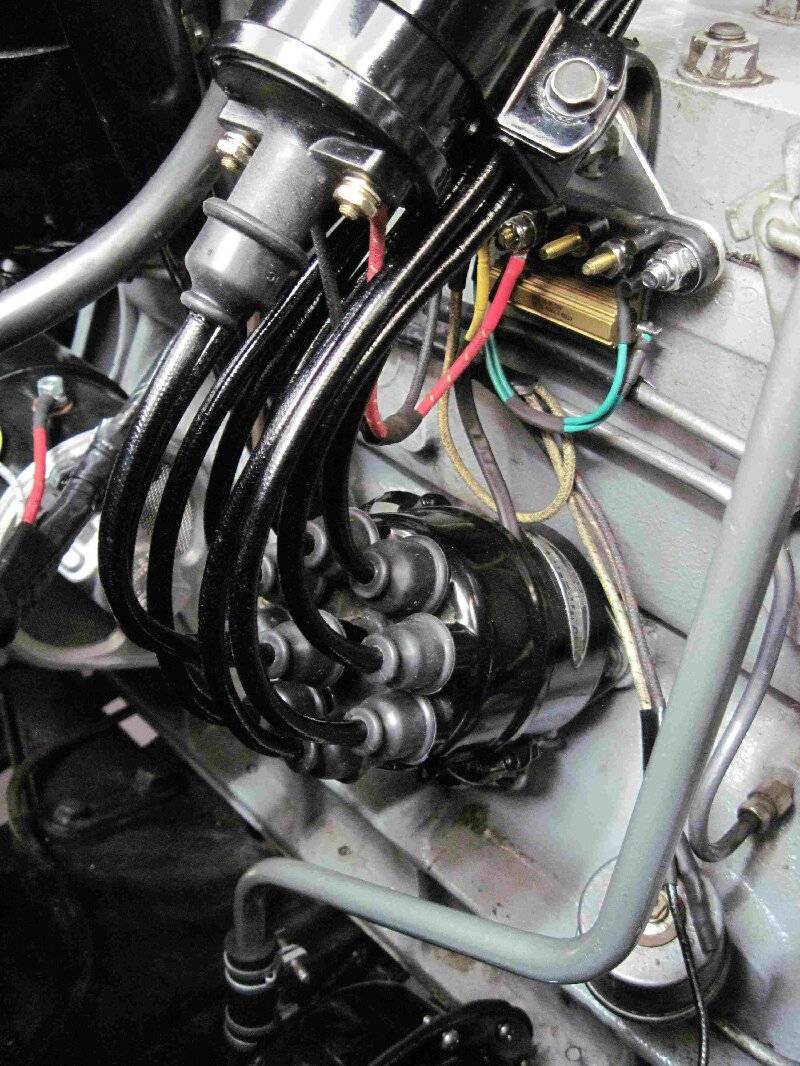|
Re: Electronic ignition
|
||||
|---|---|---|---|---|
|
Quite a regular
|
I've done it on a Ford, also 6v positive ground. It's quite straightforward. It will not look quite stock under the hood but it's nothing glaring and easily converted back to stock. The kit was a Pertronix.
It seem most issues result from the coil or improper installation as opposed to issues with the unit itself. I personally prefer to keep the original system as it is adequate and easy to fix on the side of the road. But there's no denying a better spark will improve combustion and benefit drivability and the long term life of the engine.
Posted on: 2021/7/24 22:15
|
|||
|
Alberta - Canada
Wanted - 22nd Series Custom Eight, Overdrive + Electromatic Clutch |
||||
|
||||
|
Re: Electronic ignition
|
||||
|---|---|---|---|---|
|
Home away from home

|
I don't think it would be a problem if the
EI was made for positive groundhttps://blog.simonbbc.com/electronic-ignition-pages/articles/ I'm sure there a more options then that one. You can't tell if the car has EI since it is under the cap. After I bought my 56 Packard back in 1988 I drove out to diamond bar to the pertronix company and with their help found a unit for the Packard, it actually was for a Caddy but since the Delco is part of GM. Never had one minute of problem with it. Best
Posted on: 2021/7/24 22:21
|
|||
|
||||
|
Re: Electronic ignition
|
||||
|---|---|---|---|---|
|
Forum Ambassador
|
The 12v Pertronix seems to work well but the 6v is another story. If the car's electrical system is in top notch condition and the generator is outputting the recommended 7+ volts when running then it seems to work adequately.
There is no room for error or voltage drop with the 6v units and if the least bit of typical old car maladies with dirty electrical connections seep in the 6v unit becomes temperamental. If the starter is pulling a lot of current and the voltage drops the typical almost 1 volt at the time it is most needed the spark can become very erratic resulting in hard starting. Some are very fortunate with their 6v units but many who have tried them have removed the Pertronix and gone back to points for that reason. I suspect many had some serious electrical issues at the bottom of the issues but it still affected the Pertronix perceived reliability. You can search here and the PAC forum for some first hand experiences.
Posted on: 2021/7/24 22:57
|
|||
|
Howard
|
||||
|
||||
|
Re: Electronic ignition
|
||||
|---|---|---|---|---|
|
Just can't stay away
|
I’ve had mixed thoughts as well but,this is my first car and having lots of past experiences with antique tractors (mostly old John Deere’s with the flywheel start ) the old systems worked well . Even when these cars were daily drivers or tractors used hours at a time in the fields .
I’ve come to the conclusion that if the ignition system is healthy and engine timing is spot on as well as carburetor health then these upgrades aren’t needed . I’ve seen guys crank to the point of blisters on their hands and running battery’s dead trying to get engines started . If it’ right then it’ll hit the first few cranks . My 22nd literally fires in a few revolutions of the engine . Sounds like a sewing machine running . So my opinion is the amount of cost of pertronix would be inferior compared total replacement of the complete ignition system parts . Best spark is achieved by a good coil . Breakerless ignition has nowhere the effect on spark quality compared to the condition of the coil .
Posted on: 2021/7/25 9:27
|
|||
|
||||
|
Re: Electronic ignition
|
||||
|---|---|---|---|---|
|
Home away from home
|
I used the 6 volt positive ground unit on my '41. Keep in mind that the Pertronix needs a minimum of 4.5 volts to work. I had a large voltage drop at my ignition switch. I did not want to use a repro switch, so I ran a dedicated wire from the positive battery terminal to a toggle switch hidden under the dash and then to the coil. The Pertronix never failed. John
Posted on: 2021/7/25 10:58
|
|||
|
||||
|
Re: Electronic ignition
|
||||
|---|---|---|---|---|
|
Home away from home
|
The only difference in appearance is that there are two wires coming from the distributor to the coil rather than just one but relatively easy to disguise. Never any trouble with 6v Pertronix.
Posted on: 2021/7/25 11:51
|
|||
|
||||
|
Re: Electronic ignition
|
||||
|---|---|---|---|---|
|
Home away from home

|
Re: Pertronix Ign.
In 9/2011 I installed the 6 volt, pos ground ign system including the coil in my 1955 Dodge 270 Hemi with 6V pos ground. No problems in 10 years. I bought the Pertronix system from Falcon Global on ebay. Do it, easy install. Good luck Steve
Posted on: 2021/7/25 11:58
|
|||
|
Steve
Old cars are my passion  1951 Packard 200 1953 Packard Clipper Custom Touring Sedan 1955 Dodge Custom Royal Lancer Tri-tone 1966 Rambler Classic 770 Convertible |
||||
|
||||
|
Re: Electronic ignition
|
||||
|---|---|---|---|---|
|
Home away from home
|
Paul;
I’ve had success with both 12(-), and 6(+) Pertronix ignition systems. The local Model A expert that Ernie and I know is quick to caution about installing a Pertronix ignition module electrically close to an alternator. His advice is to connect the ignition module directly to the battery. I’ve been thinking about that advice for quite a while and the only thing I’ve come-up with is the potential of an AC component in the alternator output, especially if the internal capacitor is weak/fails, and I’m not real sure whether that type of failure is detectable without an oscilloscope. Readers should know that a Model A produces quite a bit of electro-magnetic interference from the secondary side of the ignition system, and the Pertronix system seems to be immune to this type of environment, but I suspect they conduct quite a bit of testing within EMI environments. The years of service using Pertronix ignition are; 15 years (12-), 8 years (6+), and 5 years (6+), with no known problems, or service needs. The local Model A expert also cautions about coil designs that place a resistor internally. His concern is the resistor will likely be at the bottom of the coil housing, and if the coil is oil filled the resistor may not be cooled if the coil is mounted ‘nose down’ . . . as in the Model A and ‘48-‘54 Packards. I use Pertronix epoxy filled coils that are just about in the middle of the recommended resistance range. Pertronix did say that reliability is a function of coil resistance (within the recommended range), but not enough to be concerned about. This business about coils has nothing to do with whether the ignition is electronic or points, and the guy that specializes in Model A sees a lot of failed parts and tries to spread the word when he runs across a problem. Pertronix’s recommendation on how to implement the functionality of the overdrive kick-down feature in one of their 6+ units is in the attached file. Seems the 7 ohm circuit will defeat the spark sufficiently, while also limiting the current through the ignition module. Without the resistor the kick-down circuit would essentially ‘short to ground’ the ignition module for whatever the latent time is to have the overdrive solenoid change position. I suspect, but don’t know by how much, that the ignition module’s reliability would suffer with the module shorted to ground. Paul I think you can install an electronic ignition with a good amount of stealth, however on an Autolite system the Pertronics wires will enter the distributor versus the external connection on the OEM unit. My goal was to install the Pertronics system without altering the stock wire loom, so I mounted a barrier strip to make all of the connections (within reach of the stock loom), and mount the 7 ohm resistor. All of that mess was mounted to the side of the cylinder head hiding under the coil and ignition wires. I agree with Mechagon, the conversion is straightforward, and is not glaring even if you include the constraint of ‘do no harm’. HH56 comment about having almost ‘no room for error’ with a 6 volt starting system is equally correct. I have a NAPA 3EH battery, and soldered AWG 00 cables in my ’48 288, and that combination is acceptable. There are no substitutes for cold cranking amps and circular mils. Paul it’s up to you . . . its 100% reversible if you decide to restore the car to ‘as built’ condition. dp
Posted on: 2021/7/25 19:01
|
|||
|
||||
|
Re: Electronic ignition
|
||||
|---|---|---|---|---|
|
Home away from home
|
Paul;
I found a close-up view of the way I mounted the kick-down circuit resistor. That circuit would be the green colored wires. The resistor is an Ohmite item with soldered connections. Again when you’re standing looking into the engine bay most of this stuff is hidden by the coil and ignition wires, and if your car is not equipped with an overdrive none of this is necessary. I forgot a few other subjects; first if you use a Pertronix coil, or any other aftermarket coil. Those items are likely without an integral mounting bracket. I know back in the day some coils used an integral coil bracket, while the others did not. If your car has a coil with an integral bracket, and you intend to use an aftermarket coil, then you will need to fabricate, or source, a hold-down bracket/strap. The good news is that ignition coil diameters have not changed in the last 80 years, and you don’t need to change the coil, but it is part of the ‘extra ignition voltage’ scheme. I made a hold down strap out of flat stock bent over a 1 ½ pipe coupling. The trick is to get the correct length . . . missing short is better than missing long. The other item is that Pertronix suggests the use of suppression type ignition wires. I’m not sure this applies to all of their product line, because the Model A does not have ignition wires . . . let alone suppression type wires. That car uses flat strips of a copper alloy (alloy and shape depends on the which year/month of manufacture), and they are surely not suppressed. The Model A has 15 years of ‘zero drama’ operation with electron ignition. I also used shiny black cotton covered stranded wire wires on my ’48 (those in the picture), but have subsequently changed to suppression type leads . . . nothing seemed to change when the wires were changed, so I’m not sure about the Pertronix guidance on suppression wires, and whether that guidance is for the entire product line. dp
Posted on: 2021/7/25 20:27
|
|||
|
||||

 pertronix6VPGInstallationInstructions_withOverDrive.pdf
pertronix6VPGInstallationInstructions_withOverDrive.pdf 006A.JPG (292.64 KB)
006A.JPG (292.64 KB)






